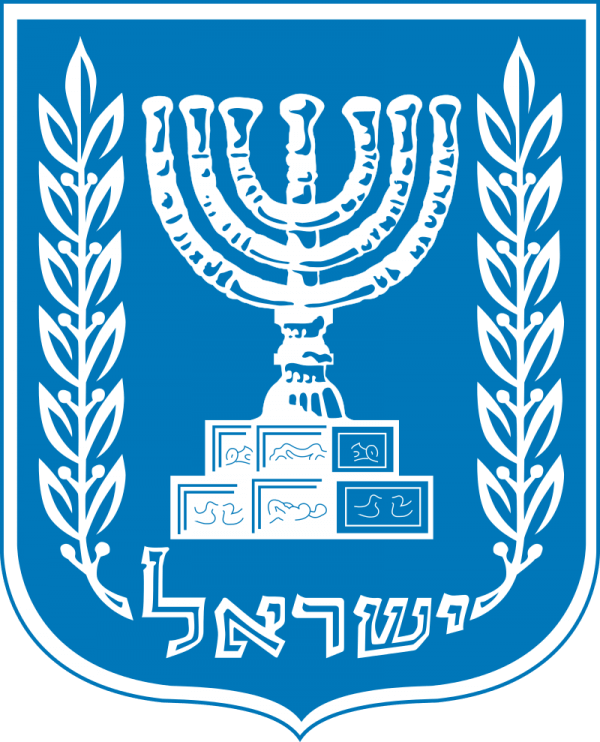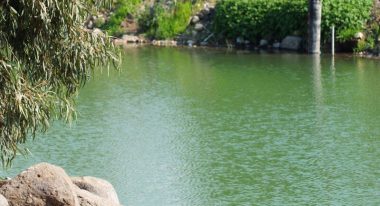
The National Symbols of Israel: Flag, Emblem and Anthem
The State of Israel
Israel is located in south-west Asia; the country has land borders with Lebanon in the north, with Syria in the north-west, with Jordan in the east and with Egypt in the south-west.
State territory is washed by the waters of the Dead Sea and Mediterranean Sea. In the south Israel has access to the Red Sea.
The State of Israel was founded on May 14, 1948.
Israel is a democratic republic that operates under a parliamentary system. Israeli parliament is called Knesset. The prime-minister is the head of Israeli government.
The Flag of Israel
The flag of Israel depicts two blue horizontal stripes on a white background. In the center of the flag there is a blue six-pointed star, known as the Star of David.
The proportions of the flag of Israel are 8:11.
The blue stripes on the flag resemble traditional Tallit – the Jewish prayer shawl. They also remind of the Parting of the Red Sea as it was described in the Exodus.
White color reflects purity and chastity of the Zionist’s ideals.
The Star of David or “The Shield of David” refers to the ancient magical symbol used for protection. Today, the Star of David is recognized in the entire world as a national Jewish symbol.
White and blue as the colors of the national Jewish flag were first mentioned by the poet Ludwig August von Frankl, in his poem, published in 1878.
170 projects of the flag were offered when it became necessary to adopt the national flag of Israel.
The final version of the flag was made by the famous painter and graphic artist Richard Arel, born in Germany.
The flag of Israel was officially approved by the October 28, 1948.
The National Emblem of Israel
The national emblem of the state of Israel is based on a French type heraldic shield with Menorah in the center, frame of olive branches and word “Israel”, written in Hebrew under the Menorah.
The shield is blue; the name of the state, menorah and olive branches may be white or golden.
The State Emblem of Israel was adopted in 1949, after the competition held in 1948. The sketch of the emblem was presented by Shamir brothers, Gabriel and Maxim.
The Menorah depicted on the State Emblem of Israel has a specific prototype – the Menorah on the triumphal arch of the Roman Emperor Titus in Rome.
In Judaism the Menorah is a symbol of divine protection, wisdom and life in general.
Olive branches, a symbol of peace, were offered by the first Israel’s President Chaim Weizmann.
The Anthem of Israel
The anthem of Israel is based on the song “Tikvateynu” (“Our Hope”) the first draft of which was written in 1877 by Naphtali Herz Imber. According to one explanation, the verses were dedicated to the establishment of the Petah Tikvah settlements in Palestine.
In 1988 Shmuel Cohen, a native of Bessarabia, settled in Rishon Lezion, put words of the song in people’s melody.
The song has gained immense popularity and gradually became the anthem of the Zionist movement. It was performed at conventions and congresses.
After the foundation of the State of Israel, “Hatikvah” de facto became the national anthem of Israel. The official status of the anthem was designated by the Knesset decision of 10 November 2004.
Words of the “Hatikvah”
“Hatikvah” text in Hebrew:
| עוֹד לֹא אָבְדָה תִּקְוָתֵנוּ, הַתִּקְוָה בַּת שְׁנוֹת אַלְפַּיִם, לִהְיוֹת עַם חָפְשִׁי בְּאַרְצֵנוּ, אֶרֶץ צִיּוֹן וִירוּשָׁלַיִם. |
כֹּל עוֹד בַּלֵּבָב פְּנִימָה נֶפֶשׁ יְהוּדִי הוֹמִיָּה, וּלְפַאֲתֵי מִזְרָח, קָדִימָה, עַיִן לְצִיּוֹן צוֹפִיָּה, |
Transliteration of “Hatikvah” text:
|
Kol od balevav penimah, |
Od lo avdah tikvateinu Hatikva bat shnot alpayim, Lihyot am chofshi be-artzeinu, Eretz tzion, virushalayim. |
Translation of the “Hatikvah”:
| As long as in the heart within, The Jewish soul yearns, And toward the eastern edges, onward, An eye gazes toward Zion. |
Our hope is not yet lost, The hope that is two-thousand years old, To be a free nation in our land, The Land of Zion, Jerusalem. |






